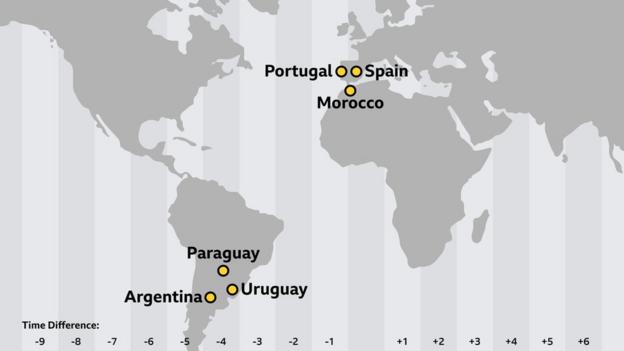
Six countries. Five time zones. Three continents. Two different seasons. One World Cup.
The proposed plans for the 2030 tournament – to be held in South America, Africa and Europe – are difficult to imagine as a reality.
It will be the first time a World Cup has been played on more than one continent – 2002 was the only previous event with more than one host in neighbouring countries South Korea and Japan.
That will change when the USA, Mexico and Canada host in 2026 – but that will not match the scale of the 2030 World Cup.
Spain, Portugal and Morocco have been named as co-hosts, yet the opening three matches will take place in Uruguay, Argentina and Paraguay to mark the World Cup’s centenary.
But how will it all work? And what are the likely implications for players and fans? BBC Sport takes a look at the key issues.
Can a single country stage a 48-team World Cup?
Uruguay, Paraguay and Argentina will each host a single game at the start of the tournament to mark 100 years since the inaugural event in Montevideo.
The Uruguayan capital will stage the opening game in 2030, with matches in Argentina and Paraguay to follow before the rest of the 48-team tournament takes place in north Africa and Europe.
It means once those early fixtures are complete, the tournament will be split between three nations – as is planned for the 2026 World Cup.
The World Cup will be expanded to host 48 teams for the first time when it is staged across 16 host cities in the US, Mexico and Canada.
That, along with Fifa’s decision to retain the four-team group format, will mean the number of matches increases from 80 to 104, alongside the introduction of a new last-32 stage.
While only one of 22 previous World Cups has had more than one host nation, the increased scale of the tournament means multi-nation bids may become more attractive to prospective bidders.
Will it really be in two seasons?

The change of hemispheres means some teams could find themselves in the bizarre scenario of playing in two different seasons at the same World Cup.
Those who will feature in one of the opening three matches in South America before resuming the rest of their tournament in Europe or north Africa would switch from winter to summer in a matter of days.
In June, Uruguay experiences cool average temperatures of between 8C and 15C in winter, while at the same time the temperature in Morocco could be above 30C.
Neighbouring Argentina sees similar ranges to Uruguay while, to the north, Paraguay has a warmer average high of 23C.
But that is still far cooler than the summer heat expected in parts of Spain and Portugal which, like Morocco, have average daily maximum temperatures of about 35C by July.
What about issues around travel, scheduling & the environment?
Further details will be revealed in due course, but it is clear there will be significant extra travel required for all involved – including fans hoping to follow their team.
Any planning for the event will have to be put on hold until information around host cities and schedules is released. When it is, the movement required between continents and countries could prove very costly.
The scheduling could also be problematic for those watching from afar, certainly in the early stages, with a five-hour time difference between Paraguay and Spain.
That provides an additional issue for those drawn to play their opening match in South America, with an average flight time of about 13 hours between Argentina and Spain.
The extra travel has also raised questions over Fifa’s commitment to sustainability after its claims that Qatar 2022 would be carbon neutral were called “dangerous and misleading” by environmentalists.
By the world governing body’s own estimation, the 2026 World Cup – predicted to deliver a potential profit rise of £521m – will be the most emitting tournament it has ever staged.
Fifa president Gianni Infantino said the decision to expand the World Cup was led by a need for the tournament to be “more inclusive” and was “not at all a money and power grab”.
Fifa told BBC Sport it is “fully aware that climate change is one of the most pressing challenges of our time and believes it requires each of us to take immediate and sustainable climate action”.
It added: “Fifa is also fully aware of the impacts that mega-events have on the economy, the natural environment and on people and communities, and has been making substantial efforts to tackle those impacts.”
The governing body said it “will implement a robust sustainability strategy for the event. Fifa will do everything possible to maximise the experience of teams, fans and officials while minimising the impact on the environment.”
‘A logistical nightmare’ – what will it feel like for fans?
World Cups are synonymous with their hosts, their staging of the event and the opportunity for teams and fans to engage in the wider culture.
With several host nations – all six of which are to receive automatic entries to the tournament – it is likely many will have different experiences of the same tournament.
If the proposal is approved at a Fifa congress next year, Morocco will become only the second African nation to host after South Africa in 2010. Portugal will host for the first time, while Spain has not staged the tournament since 1982.
But could the enjoyment for those hoping to travel be affected by the scale and costs associated with the upcoming tournaments?
“For a fan it would be a logistical nightmare,” England football fan Garford Beck, who travels to watch the team at major tournaments, told BBC Radio 5 Live.
“It was horrendous in Russia, going down from Moscow to Samara for the quarter-finals was 18 hours each way on the train.
“I think what they don’t get is that fans don’t like tournaments in two countries, let alone six or three.”






